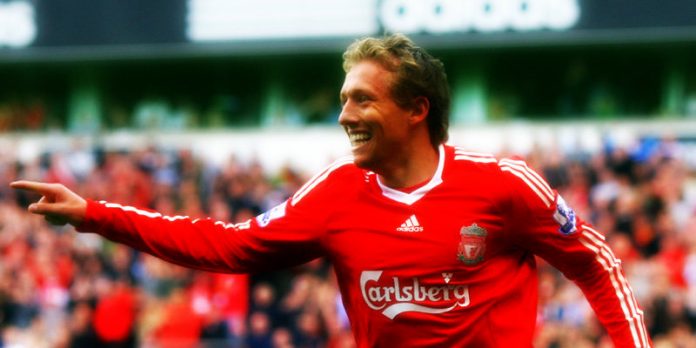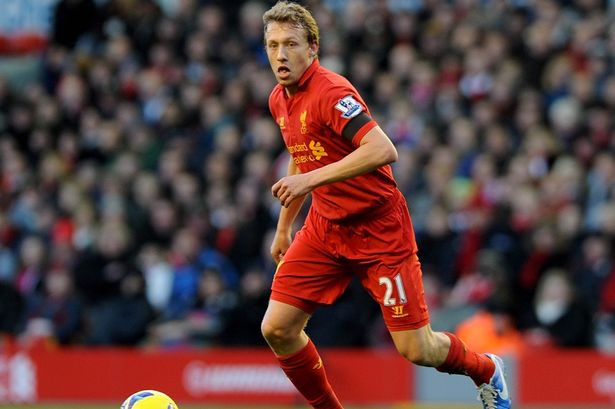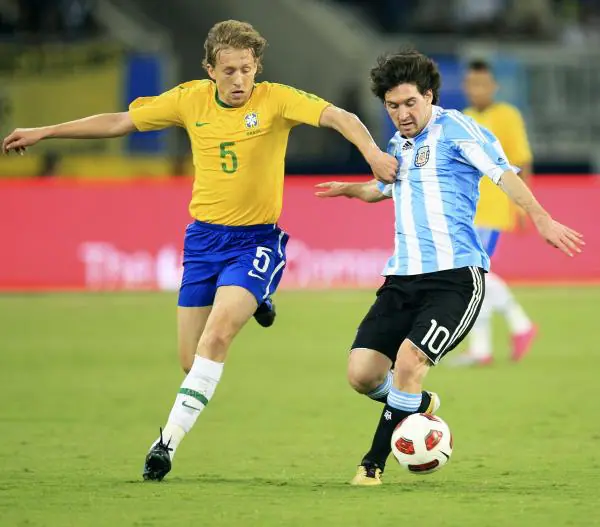The return of Lucas Leiva on Saturday was a huge positive for Liverpool, with many claiming it will be the catalyst in igniting Liverpool’s stuttering season.
Despite his universal popularity among Liverpool fans, it is to easy forget that the Brazilian was once the least popular player at the club.
When Rafa Benitez signed Lucas for £5 million in the summer of 2007 he was a highly rated 20 year old, seen as a terrific midfield prospect. He had just won the Bola de Ouro, the Brazilian equivalent of the PFA Player of the Year award, after a superb season with Gremio.
The fact that players of the calibre of Zico, Romario, Kaka and Carlos Tevez had won the award previously showed how highly Lucas was rated.

Apart from winning Liverpool a crucial penalty in a dramatic 3-2 win over Everton at Goodison Park, he had a disappointing first season at the club, with many supporters frustrated at Benitez’s insistence on playing him so frequently. He looked nervous on the ball and was technically poor, particularly for a Brazilian.
The 2008/09 season was Liverpool’s most impressive in the Premier League era, and the trio of Xabi Alonso, Javier Mascherano and Steven Gerrard were arguably the most complete midfield in Europe at the time. This gave Lucas limited opportunities to show his worth, but whenever he did play he was invariably disappointing.
Liverpool fans are a very loyal bunch, but even they grew restless with the Brazilian’s lack of impact. After a drab draw with Fulham he was booed incessantly, and things were about to get even worse for him. Having conceded a penalty against Wigan, he was then red carded against Everton, and his popularity hit an all time low, with many calling for him to be sold.
In 2009/10, following the departure of Alonso and an injury to new signing Alberto Aquilani, Lucas became a regular alongside Gerrard in the centre of midfield, playing 50 times in all competitions.
The season was a poor one for all concerned at the club, and having promised so much the previous year Liverpool finished 7th. While Alonso’s departure was the key factor for such a poor campaign, Lucas’s inability to stamp his authority on the team was also a major issue.
There were slight signs that he was slowly beginning to mature, but very few felt he had the quality to become a key player at such a big club.

Between Lucas’s arrival in 2007 and Benitez’s sacking in 2010, the Spaniard always stood up for the likeable Brazilian, claiming that he was hugely underrated. While many ridiculed these comments, the last couple of years have shown that Benitez knew what he was talking about.
Roy Hodgson arrived in the summer of 2010, and although his reign at the club was disastrous, this was the year that Lucas came of age.
Although it is something of a cliche, he looked as though he had matured from a boy to a man between May and August 2010. Physically he looked more imposing, and there suddenly seemed to be an authority about his game.
With Mascherano now at Barcelona and Gerrard missing a large chunk of the 2010/11 season through injury, Lucas was the main man in midfield.

His tackling, distribution and all-round influence on the team did not go unnoticed with the fans, and he was deservedly voted Liverpool’s Player of the Year.
At 24, he was now an experienced player but one whose best years were still way ahead of him.
If ever his importance to the side was now in question, he had made more tackles than any other player in the top four European League’s that season. That statistic alone was proof of how far he had come as a player.
He started last season in similarly terrific form, and he had again been Liverpool’s standout player when a cruciate ligament injury against Chelsea in December cruelly saw him ruled out for the remainder of the campaign. Liverpool missed him greatly.
Although he was now a crowd favourite at Anfield, with many rating him among the most assured defensive midfielders in the league, his reputation was actually enhanced further while he was on the sidelines.
Much like Jack Wilshere at Arsenal, Lucas’s injury made people throughout the football world realise what a class act he had become.
Having returned at the start of this season injury again struck, with a thigh problem against Manchester City ruling him out for a further three months.
New manager Brendon Rodgers has struggled to get a balance in the midfield without him in the side, with Gerrard playing far too deep and lacking the influence he has when playing further up the pitch.
Similarly Joe Allen, who has been solid but unspectacular for Liverpool, has not played with the freedom he did at Swansea, where he had Leon Britton playing Lucas’s role to great effect.
Put simply, Lucas makes others around him play better by doing their dirty work. Andres Iniesta and Xavi are wonderful players, but without Sergio Busquets they would not have to same license to attack.
At Chelsea, Jon Obi Mikel is often not given credit for the amount of work he gets through, giving the likes of Juan Mata, Eden Hazard and Oscar the chance to play with more freedom.
On Saturday, Lucas made his return from injury to a hero’s welcome. Although Liverpool only won 1-0 against a struggling Southampton team, Lucas’s influence was clear to see, and the side had a far more balanced look to it. He made more tackles and interceptions than any other player in the Premier League this weekend, which tells it’s own story.
At international level, Lucas had also become a regular before his injuries, and his return will be a huge boost to new manager Luis Felipe Scolari.
Brazil are world-renowned for their sensational attacking talents over the years – Pele, Ronaldo, Ronaldinho, Kaka, Neymar – but the likes of Gilberto Silva and Dunga have always been criminally underrated for their roles in the side.
Lucas has become that player for Brazil, where he is a cross between Claude Makelele and Xavi, doing the ugly work in defensive but also building attacks. As long as he stays fit he will be a key player for Brazil when they host the 2014 World Cup.
At 25, Lucas Leiva still has years ahead of him at the top, where is he now a key player for club and country. He has come a long way since he was booed by his own fans and was the subject of ridicule from rival supporters. There is hope for Jordan Henderson yet.
Follow me on twitter: @henryjackson87, go to www.OnFootball.co.uk to read more of my work
Add Sportslens to your Google News Feed!



